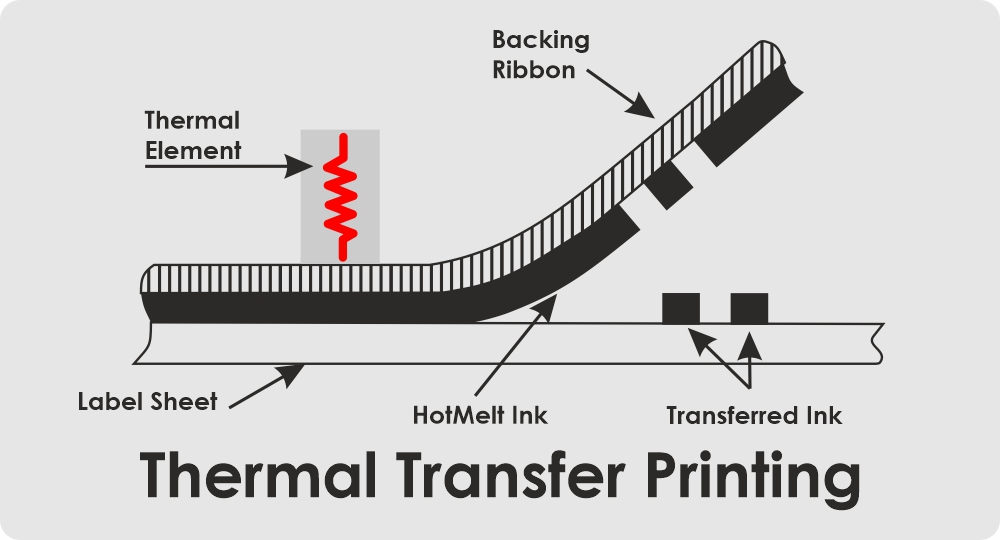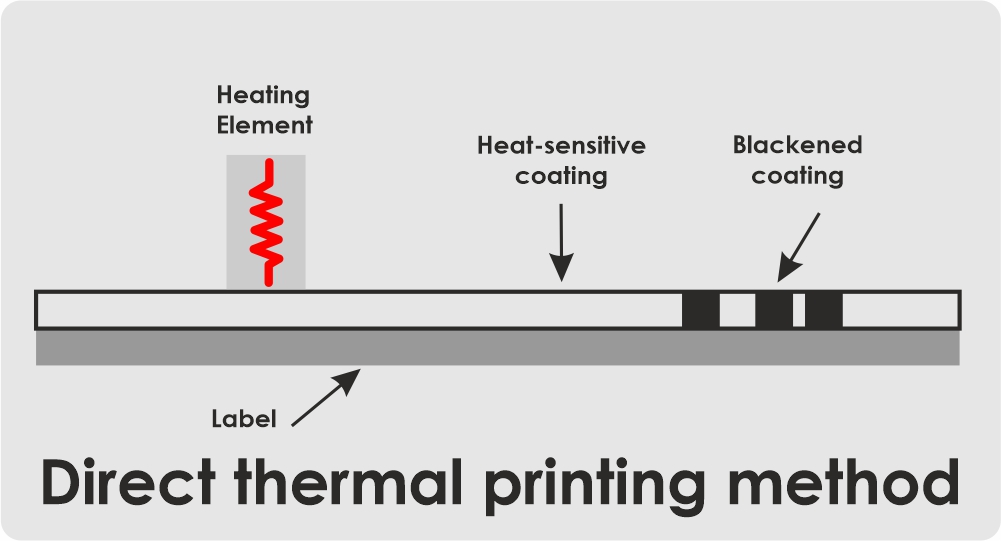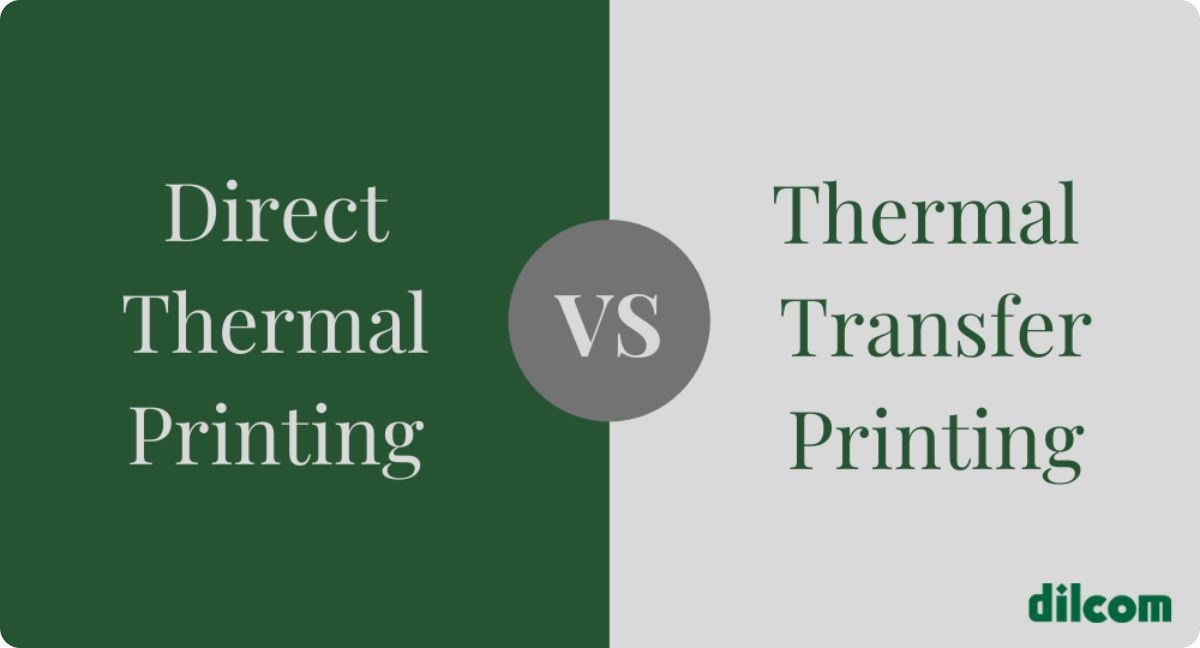Date: 14 May 2021
Thermal printing is one of the most developed and commonly used technologies for printing barcodes and other variable information onto labels. This method delivers high-quality barcodes with excellent edge definition and thus can guarantee effortless long-term scanning and product tracing. Variable data such as barcodes and serial numbers are used in many of today’s work processes. Among these processes are product tracking, logistics, compliance with legal standards in various industries and fighting against counterfeit. For these applications, imprint durability is extremely important.
There are two different kinds of thermal printing – direct thermal and thermal transfer. Some label printers can work with only one of the two methods. that is why it is important to keep your label application in mind when purchasing a printer. In this blog article we will introduce you to both technologies in order to help you make the right decision for your label printing needs.
Thermal Transfer Label Printing

Thermal transfer printing is very commonly used in many industries worldwide. With this technology, the printhead heated elements precisely apply heat onto the passing thermal transfer ribbon. This causes it to melt onto the label and form a preset image. The label absorbs the ink and thus the desired information is transferred onto the substrate.
Thermal transfer printing is applicable when you need your labels to adhere to strict requirements regarding the print quality. It is used to guarantee the resistance and flexibility of the label material, because this method delivers the most durable results. Using a thermal transfer printer is the standard choice for single-color label printing. This technology’s capabilities are wide-ranging. It allows the printing of a large variety of customized labels with many different specifications.
This is one of the most commonly used methods for printing variable information on high-quality durable barcode labels for product identification. They contain information such as barcodes, serial numbers, date, price, expiry date, batch numbers and other data.
High-quality printing with a thermal transfer label printer is a secure technology that will ensure durable results in variable data printing.
This is extremely important in many sectors such as the automotive industry. Here, many of the different parts of vehicles have to be labeled with a barcode and other variable information. This is done to ensure the long-term ability to scan and trace products.
This application has tough conditions such as exposure to extreme temperature, friction, oils and UV light. That is why the imprint has to be extremely durable and resistant. Thermal transfer printing is a proven solution for these needs. This method succeeds in providing results that can adhere to even the most rigorous industry standards.
This technology also allows the printing of entertaining labels for marketing purposes and security labels that can assist in the fight against counterfeiting. Depending on the specific thermal transfer ribbon you use, you can print labels with different colors, holographic images, UV fluorescent labels and scratch-off labels.
Due to the many capabilities and good qualities of this technology, thermal transfer printing is very widely used. Characteristic for it is that the printer,thermal transfer ribbon and label substrate work together as a system. Picking these different elements has a direct impact on the scannability, readability and reliability of your labels. In order to achieve optimal results and the highest print resistance possible, they have to be carefully coordinated with each other.

Direct Thermal Label Printing
Direct thermal printing is a process in which the imprint is formed when the print head applies heat directly onto a special type of thermal paper while the paper is passing under the printhead. This causes a chemical reaction to occur in the special heat-sensitive layer of the thermal substrate with which the labels are coated. The coating turns black (or another color) in the specific zones that it is directly heated.
In direct thermal printing you do not need a ribbon, toner or ink but only chemically treated thermal paper. Due to this, thermal direct printers can be easier to use. They are also faster than thermal transfer printers, because you save time when reloading the printer. The other advantage of this method is that it produces less waste as you need less printing materials. In comparison with thermal transfer technology, this method is an eco-friendlier label printing option, through which less carbon dioxide is released.
The main disadvantage of direct thermal printing is that the printed image may fade after a certain amount of time. The thermal paper and imprint are sensitive to light, heat, chemical solvents and abrasion. If they are exposed to these factors, the material will darken. The text and barcode will not be readable or scannable. For these reasons, the life cycle of these labels is short. Direct thermal printing is not recommended when you need long-term product identification.
Another disadvantage of this technology is that at the moment of heating, the thermal head is in direct contact with the labels. The labels might have a rough or uneven surface, or possibly be dusty. This leads to wearing out and increased costs for printhead replacement, which is one of the most important parts of your printer.
Direct thermal labels are a high-quality effective and flexible solution for many different applications. They may have a different degree of readability during the period of exploitation depending on the environment and manner of use.
For instance, they could last six months in storage but not when the labeled product is kept outside. Thus, this method is most often used for general purpose labels with a short shelf life. Using a direct thermal printer is suitable for logistics labels, event tickets, visitor passes and other similar applications.
In conclusion, both types of thermal printing are extremely common as they guarantee a clean imprint and excellent edge definition. They are a high-quality solution for many different industries and applications. Because of the characteristics mentioned above, thermal transfer printing is recommended in these cases:
- when you need a large number of barcode labels
- when you would like to protect the printhead
- when you need the printed image to be durable and readable for a long period of time
- when your thermal labels have to be resistant to heat, chemicals and other harsh conditions.
If you are not looking for such a durable solution but need general purpose labels with a short shelf life, you can use the direct thermal method. In order to achieve optimal results, it is very important to match your specific application to the desired technology for thermal printing.
If you need more information or a free consultation, please make an inquiry or contact us at sales@dilcom.com. As a company with 19 years of experience in the sphere of labeling, we can offer you the right solution carefully tailored to your business needs and requirements.


Post comment